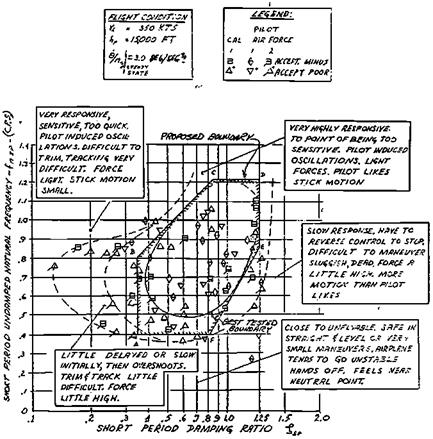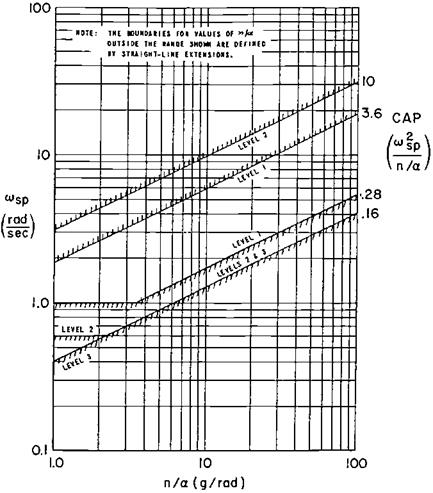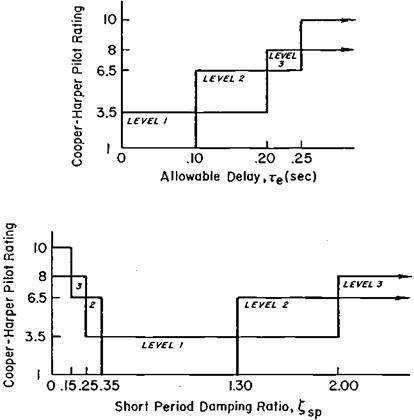10.3.2 Criteria Based on Equivalent Systems
A brief summary of the criteria based on airplane-alone or equivalent system transfer functions is as follows:
|
Figure 10.3 Example of an early iso-opinion chart for the longitudinal short-period mode. This one was derived from flight tests of the variable-stability F-94F airplane. (Mazza, Becker, Cohen, and Spector, NADC Report ED-6282, 1963) |
Frequency-Damping Boundaries Historically, the earliest findings on pitch sensitivity and sluggishness from variable-stability airplane research was bulls – eye-type pilot opinion contours of the two denominator parameters of the pitch transfer function: natural frequency and damping ratio (Figure 10.3). This work was done by Robert P. Harper and his associates at the Cornell Aeronautical Laboratory in the early 1950s. Gibson (1995) comments that these boundaries ignore the attitude response. He suggests adding quantitative information on attitude response, such as delay, dropback (see subsequent definition), and overshoot.
Numerator Time Constant Requirements The numerator time constant, Tg2, controls the rapidity with which attitude changes result in flight path changes. Shorter values, corresponding to high lift curve slope and light wing loadings, give faster path responses and lower, or better, Cooper-Harper ratings. However, the benefits of low numerator time constants are mainly confined to landing approach control and have little to do with tactical airplane maneuverability.
Bihrle’s Control Anticipation Parameter By far the most successful of the criteria based on pitch transfer function parameters is the control anticipation
|
Figure 10.4 MIL-F-8757C short-period mode equivalent natural frequency and CAP (Control Anticipation Parameter) requirements (1980). |
parameter, or CAP (Bihrle, 1966). CAP is the ratio of the airplane’s initial pitch acceleration in an abrupt pullup to the steady-state normal acceleration produced. The initial pitch acceleration lets the pilot anticipate the final acceleration response. It turned out that CAP also could be expressed as the ratio of the pitch natural frequency to a function of the numerator time constant. In that form CAP appears in MIL-F-8785C (Figure 10.4) and is also referenced in the newer MIL-STD-1797. CAP is augmented by requirements on damping ratio and time delay (Figure 10.5).
Gautrey and Cook’s Generic CAP, or GCAP The CAP criterion can be extended to augmented aircraft without recourse to equivalent systems. The generic CAP criterion, or GCAP, uses different parameters than CAP but has the same interpretation. GCAP is neither based on short-period transfer function parameters nor does it require a steady-state normal acceleration, as does CAP. GCAP parameters are well defined even for fully augmented pitch control systems such as are found on the Boeing 777 and Airbus A320-A340 series.
|
Figure 10.5 Equivalent systems requirements for longitudinal short-period damping and time delay. (From MIL-F-8785C, Nov. 1980) |
Bandwidth Criterion This is a criterion based on the transfer function for pitch attitude as an output for control force as an input. The pitch attitude bandwidth is defined arbitrarily as the lower of two frequencies: the gain bandwidth frequency, at which there is a 6-db gain margin, and the phase bandwidth frequency, at which there is a 45-degree phase margin. An additional factor is the phase delay, which accounts for phase lags introduced by higher frequency components, such as control actuators. A typical bandwidth criterion chart is reproduced in Figure 10.6. The bandwidth criterion is considered significant, although the exact shape of suitable boundaries is still a research matter.
Gibson Nichols Chart Criterion This criterion defines satisfactory and unsatisfactory flying qualities regions in the Nichols plane of open-loop transfer function gain and phase. An early version of this criterion is shown in Figure 10.7. The concept of attitude dropback appears on the chart, a term defined subsequently.














